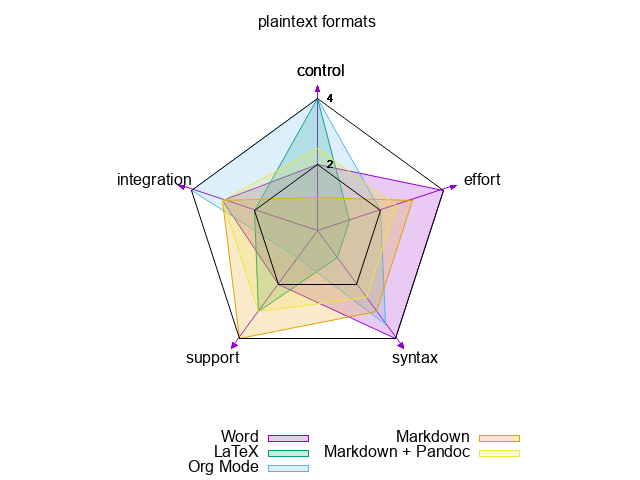Org-mode
Org-mode describes a markup language and an associated ecosystem that lives inside of emacs.
Use cases
- Bold, underlined, cursive, etc. and hyperlinks
[1/2]Checklists[X]do 1[ ]do 2
- Inline images
- Inline latex \(f(x) = x^2 + 3\)
Task management
- TODOs
- Appointments
- Scheduled events
- Deadlines
Websites
- Static website generation using
org-publish - Dynamic websites using embedded html blocks (?)
Documents
- Thesis, Papers, Articles
- Export to PDF, HTML, Markdown
- Presentations using
org-beamer - HTML mails using
org-mime-org-htmlize
PKM/Zettelkasten/Digital Garden
Programming
- Literate programming using
org-babel-tangle - Jupyter-like notebooks using
org-babel README.org(supported by GitHub, …)- TODOs tracking with filelinks
Tables
- Plaintext table generation
- Spreadsheets w/ formulas
- Plotting using
gnuplot - ASCII bar plots w/
orgtbl-ascii-draw
Attachments
File links in org-mode are manually managed, remain in their original locations and are pointed to with absolute/relative paths. This means the links are invalid if files are moved or reorganized.
Attachments on the other hand are managed by Org-mode with auto-moving when files are refiled. Files are stored in a dedicated directory and belong to an outline.
Use attachments for files that belong with the note; use file links for referencing external resources.
Org-plot example
| Format | control | effort | syntax | support | integration |
|---|---|---|---|---|---|
| Word | 2 | 4 | 4 | 2 | 3 |
| LaTeX | 4 | 1 | 1 | 3 | 2 |
| Org Mode | 4 | 2 | 3.5 | 1 | 4 |
| Markdown | 1 | 3 | 3 | 4 | 3 |
| Markdown + Pandoc | 2.5 | 2.5 | 2.5 | 3 | 3 |

Figure 1: Example of generating a plot from an org table
Resources
- The Org Manual
- org-mode-doc: Org-mode as your personal information manager
- org-almanac: A list of org resources